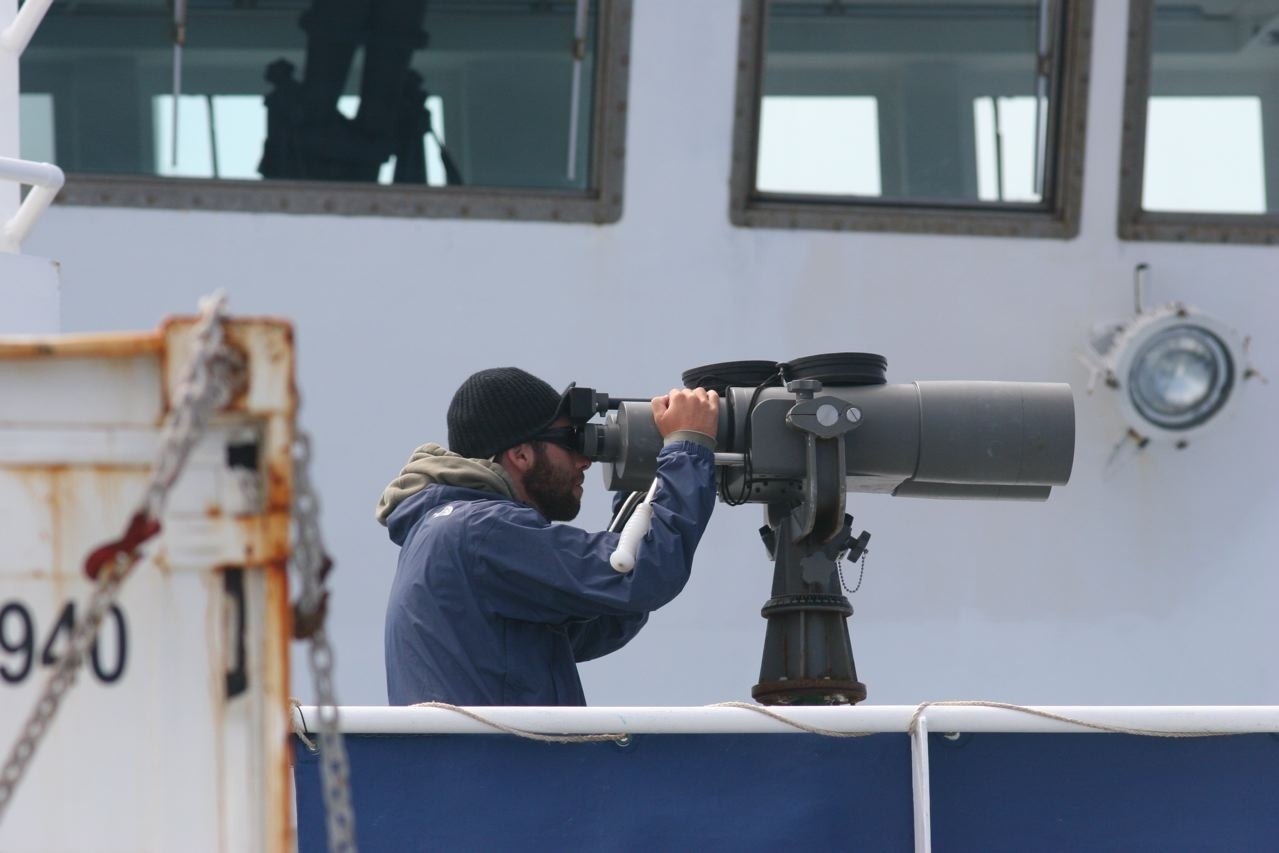Protected Species Observers
Information for Protected Species Observers engaging in monitoring activities.

Protected Species Observers (PSOs) are trained professionals who monitor for protected species, i.e., animals federally protected under the Endangered Species Act (ESA) and/or Marine Mammal Protection Act (MMPA), to help meet regulatory compliance needs.
Projects that may require Protected Species Observers include construction and demolition, pile driving, explosive blasting, and geophysical (seismic) surveys. Observation work is typically focused on detection of marine mammals (such as whales or dolphins) and sea turtles, but observers may also encounter other protected marine species, such as manta rays, sharks, salmonids, and sturgeon, swimming near the water’s surface.
A Protected Species Observer is different from an observer working under a Fisheries Observer Program. The training, duties, and approval process are different for fisheries and protected species observers, and may not be transferable.
Protected Species Observer credentials are reviewed by NOAA Fisheries for specific projects to ensure candidates have appropriate training and/or experience to perform the necessary duties, e.g., detecting protected species, observing and recording protected species behavior, documenting protected species interactions, and advising regarding the need to implement required mitigation measures. While mitigation, monitoring, and reporting requirements may differ by project, Protected Species Observers must have education and/or experience, as well as appropriate training, to safely and effectively perform their required duties. The following sections contain more information about the education or experience and training that NOAA Fisheries recommends for Protected Species Observers.

Basic Criteria to Become a Protected Species Observer
In addition to the generalized education/experience and training recommended by NOAA Fisheries (e.g., National Standards for a Protected Species Observer and Data Management Program: A Model Using Geological and Geophysical Surveys), there may be project-specific experience, training, or certifications required by industry or third-party providers to meet the needs of a particular project. Protected Species Observers should consult industry standards, the regulatory conditions set out for a project, and their employer’s guidelines to ensure they are adequately prepared.

NOAA Fisheries Evaluation of Protected Species Observers
NOAA Fisheries does not conduct training for Protected Species Observers, but we evaluate the credentials of candidates to ensure they are qualified to perform Protected Species Observer duties for a particular project as required under an MMPA incidental take authorization or ESA biological opinion. For geophysical survey projects, please email nmfs.psoreview@noaa.gov. Please note that there may be additional requirements for review of PSO qualifications for projects occurring in other NOAA Fisheries regions.
Our approval of a candidate's qualifications is based on an individual’s training, education, and experience (see applicant package details). In some cases, specific work experience is an acceptable proxy for formal education. Approval may be conditional or unconditional under two tier categories[1]. “Conditional” approval means that a Protected Species Observer meets all other requirements and has been approved for on-the-job training work for a set time under an unconditional or lead observer. Protected Species Observers may receive “unconditional” approval after on-the-job training requirements have been met for that role. Please note that approvals will lapse after 18 months of inactivity and that, following an inactive period of 18 months or more, candidates must refresh their training. New candidates must have training within 18 months prior to submitting a request, or, if older training, activity-specific experience in the prior 18 months for approval.
[1] Tier 1 includes all airgun surveys regardless of size (representing Tier 1 & 2 geophysical survey categories or equivalent experience), Tier 3 represents high resolution geophysical (HRG) surveys using impulsive sources (i.e., certain boomers and sparkers) or equivalent experience. Equivalent experience includes experience performing PSO duties associated with wind turbine foundation installation.
Trainers and Providers
There are numerous companies that provide or train Protected Species Observers. Protected Species Observers should contact the companies directly for more information on training programs. NOAA Fisheries does not endorse any specific companies or their training programs. Protected Species Observers or provider companies interested in NOAA Fisheries’ evaluation of candidate qualifications should submit a resume package to nmfs.psoreview@noaa.gov. NOAA Fisheries reviews curricula and training materials provided in the Protected Species Observer’s resume package. For privacy reasons, NOAA Fisheries does not supply the names of qualified or approved Protected Species Observers to consultants or to industry.

Pantropical Spotted Dolphin Cow and Calf, Credit: Howard Goldstein
